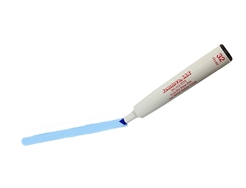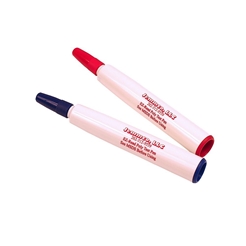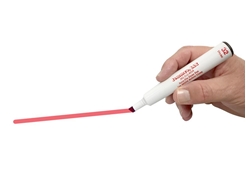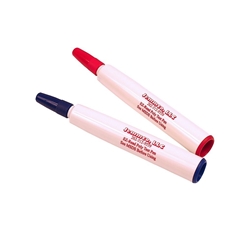Product Details
Jemmco’s Accu-Flo™ Dyne Pens are simple to use, making them perfect for use in applications where a quick reference in needed. The dark blue color solution makes them easy to read, especially in poor lighting. For this reason, these pens have proven to be perfect for use at the production line. The wicking style marker provides a constant volume of solution with each swipe, enabling more consistent results each time. They are available in even dyne levels ranging from 32 dynes through 58 dynes, which covers a wide range of applications. Best of all, Accu-Flo™ Dyne Pens are competitively priced. Jemmco’s Accu-Flo™ Dyne Pens are made specifically for each order, so that the user is assured that the pens are fresh and have not been sitting on a shelf. Jemmco puts an anticipated expiration date on each pen to remind the user when it is time to reorder. Accu-Flo™ Dyne Pens have proven to be very popular with film extruders and plastics converters. Providing a good, quick reference in production environments, users have learned to depend on Jemmco Accu-Flo™ Dyne Pens.
Note: The expiration date appearing on the pen is a not to exceed date. Pen life is dependent on use, storage conditions and exposure to the atmosphere. Pen solution that has turned green will not give reliable readings and should not be used.
How it Works
Jemmco’s wicking style, Accu-Flo™ Dyne Pens are used to measure the surface tension of a substrate. By providing a constant volume of solution with each swipe, Accu-Flo™ Dyne Pens provide more consistent and accurate results each time. They are available in even dyne levels ranging from 32 dynes through 58 dynes, which covers a wide range of applications.
Instructions
- 1.
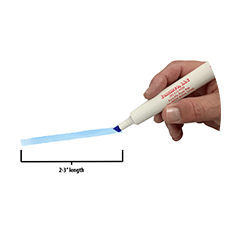
Draw a line of dyne, 2-3" in length
- 2.

Read results within the first 3 seconds
- 3.
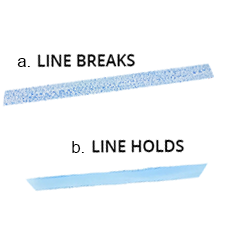
a. If your line breaks, the dyne pen/solution level is too high. Retest using a lower dyne level.
b. If your line holds, your material is at the tested level or higher.
Helpful Tips
- Inconsistent dyne application pressure may provide a false dyne reading
- Touching the tested surface could result in contamination
- Usable on almost any smooth and non-absorptive substrates
- Reliable for R&D and lab applications
- Pens should be stored at room temperature
- Contaminated pens should not be used
- 5-6 month shelf life (Accu-Flo™), 12 month shelf life (EZ Read™)
- Dyne pens should not be exposed to direct sunlight, therefore they should be closed when not in use
- Dyne level decay is very quick directly after corona treatment
- The lower the surface tension, the more power you need to treat your material
- If your treat level is too low, set your corona treater higher, treat and test again
FAQ
What Type of Dyne Pen Is Best?
There are a large variety of Dyne Pens on the market, and, in fact, Jemmco offers a wide number of styles. Despite all of these variations, there are basically two types. One type is the valve type pen, in which a valve is opened up to release the dyne solution when the pen tip is pressed down. This type of pen had been very popular, based on the belief that any surface contaminants picked up on the tip would be washed away with the solution once the valve was opened. Of course, this makes no sense since the contaminants would then be deposited on to the substrate being measured and would be affecting the solution that was used to measure the treat level of the substrate. A secondary issue with these pens is that it adds another variable to the dyne test. Since the amount of fluid released is dependent upon how much time, and how hard the user presses on the tip, it is very easy for too much fluid to be released, flooding the substrate surface, which could result in a false reading.
The second type of pen style available is a wicking type pen. Similar to a magic marker, this style pen does face the same problem as the first, regarding tip contamination, however, the solution flow is now dependent on the wicking action of the pen and not the operator. As a result, the amount of fluid deposited on the substrate is more consistent from use to use, thus eliminating one variable.
Jemmco does offer a valve style pen, our Accu-Flo™ Jumbo Pen, which uses a thick replaceable felt tip, to reduce the amount of fluid deposited, and to reduce the impact of tip contamination.
Why Accu-Flo™ Dyne Pens?
Jemmco’s Accu-Flo™ Dyne Pens are simple to use, making them perfect for use in applications where a quick reference is needed. The dark blue color solution makes them easy to read, especially in poor lighting. For this reason, these pens have proven to be perfect for use at the production line. The wicking style marker provides a constant volume of solution with each swipe, enabling more consistent results each time. They are available in even dyne levels ranging from 32 dynes through 58 dynes, which covers a wide range of applications. Best of all, Accu-Flo™ Dyne Pens are competitively priced.
Jemmco’s Accu-Flo™ Dyne Pens are made specifically for each order, so that the user is assured that the pens are fresh and have not been sitting on a shelf. Jemmco puts an anticipated expiration date on each pen to remind the user when it is time to reorder. (note: The expiration date appearing on the pen is a not to exceed date. Pen life is dependent on use, storage conditions and exposure to the atmosphere. Pen solution that has turned green will not give reliable readings and should not be used.)
Accu-Flo™ Dyne Pens have proven to be very popular with film extruders and plastics converters. Providing a good, quick reference in production environments, users have learned to depend on Jemmco Accu-Flo™ Dyne Pens.
How Should I Store My Accu-Flo™ Dyne Pens?
Accu-Flo™ Dyne Pens should be stored at room temperature with the cap on tight to prevent drying out. The Dyne Pens should not be exposed to direct sunlight.
What is the ideal surface for Accu-Flo™ Dyne Pens?
The ideal surfaces for Dyne Pens are non-absorbent materials.
What is the Dyne level of my substrate?
Check out Jemmco's list of common substrates here.

